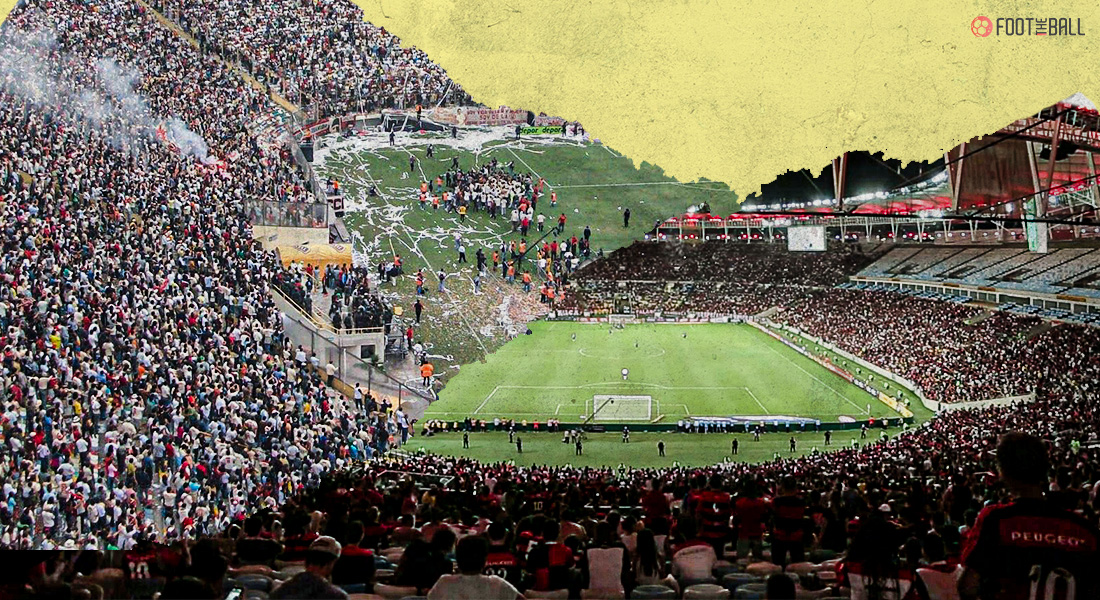South America has long-been called the talent factory of football, but something that is often overlooked is that the continent also has some of the most beautiful stadiums across the world, both in terms of design and atmosphere. As the kick off to Copa America 2021 gets closer, FootTheBall takes a look at the seven most stunning stadiums to have hosted the Copa America over the years
ESTADIO MONUMENTAL- BUENOS AIRES, ARGENTINA
This huge stadium, the largest in Argentina, with a capacity in excess of 100,000 is the home of the national team as well as River Plate. Constructed in 1938, it was finally showcased to the world for the 1978 World Cup.
Estadio Antonio Vespucio Liberti, also referred to as "El Monumental", is a stadium in the Belgrano district of Buenos Aires, Argentina, home of the football club River Plate. It is the largest stadium in Argentina with a capacity of 62,000 and is also home of the national team. pic.twitter.com/NKbE7bp3d1
— Wiki Stadiums (@wikistadiums) June 11, 2018
The stadium is built with four double decker stands surrounding the pitch with the noise reverberating throughout the stadium many times over, meaning the fans are in full blow during matches with both the finals in 1987 and 2011 being played in the stadium.
MARACANÃ- RIO DE JANEIRO, BRAZIL
The grand old stadium became famous during the 1950 World Cup with hosts Brazil losing to Uruguay in the final. The stadium is renowned for its bombastic atmosphere due to its enclosed nature of roofs above the spectators section, keeping the sun firmly on the pitch as the games go on.
— Estádio do Maracanã (@MaracanaEstadio) September 10, 2013
The Maracana saw the final of the latest edition of Copa America being played with Brazil emerging victorious as well as all the knockout matches of the 1989 edition.
ESTADIO NACIONAL- LIMA, PERÚ
Peru’s national stadium was built much in the same mold as the Maracana and is also the largest stadium in South America. The domed nature of the stadium provides for fans to be vocal for their team and even get onto the match as was evident in the 1964 Olympic games between Peru and Argentina which left more than 300 people dead.
Todo va quedando listo en el Estadio Nacional 🏟🇵🇪. pic.twitter.com/6KcKbdmhHc
— Selección Peruana 🇵🇪 (@SeleccionPeru) November 15, 2017
Since then, the stadium has undergone many safety checks including extensive face lifts and renovations under strict FIFA compliance, and was the site of the 2004 Copa America, won by Brazil.
ESTADIO NACIONAL DE CHILE- SANTIAGO, CHILE
Chile’s national stadium underwent a complete makeover in the past decade with additions including a illuminating roof over all the seats for the fans, a modern, digitized scoreboard, a “citizenry park” surrounding the entire stadium with restaurants, lagoons, stores, state-of-the-art gymnasiums for players and athletes to train and more.
https://twitter.com/MYPESBRASIL/status/1177311465210032128?s=20
The stadium was one of the major attractions for the 2015 Copa America which the hosts won after a dramatic penalty shootout against Argentina.
ESTADIO CENTENARIO- MONTEVIDEO, URUGUAY
The hosts of the first ever FIFA World Cup final in 1930, the Centenario is well-known for being the home ground of Uruguay’s most successful team, Penarol who have used pyrotechnics for the big names. It has four Grandstands divided among four lanes, for the various sections of crowd, VIP boxes, press boxes etc.
Estadio Centenario, Montevideo, Uruguay. pic.twitter.com/xPH1TySw1B
— LearnEnglishThroughFootball (@LETFootball) January 23, 2020
The circular nature of the stands gives it a dome shaped appearance and the stadium has been a formidable place for the national team including where they won the 1995 Copa America. In 1985, FIFA declared it the only historical monument of world football.
ESTADIO HERNANDO SILES- LA PAZ, BOLIVIA
Surrounded by the town district on all sides, this stadium is one of the highest in the world with an altitude of 3,637 metres above sea level. With its impressive view aerially and the colored seats, the stadium plays hosts to three first-division clubs as well lower league clubs.
Estadio Hernando Siles de La Paz a 3.600 metros sobre el nivel del mar.Hermoso Estadio donde jugó la Selección Argentina.#Guabira #Ciclon pic.twitter.com/XyEoXwLyd0
— Gonzalo Acosta (@Gonzalo18Ac) March 30, 2017
There have been concerns over playing here due to the thin oxygen at such levels but it was the site of 1997 Copa America where Bolivia made it all the way to the final before losing to Brazil.
ESTADIO CACHAMAY- CIUDAD GUAYANA, VENEZUELA
Surrounded by a river and waterfalls as well as green lands, the stadium is one of the most aesthetically pleasing across all of South America. The vinyl-covered plastic roof of the stadium runs in a U-shape with the central platforms that serve as galleries for the VIPs and press box near the entrance of the stadium.
Estadio Cachamay, estado Bolívar, Venezuela.
Fotografía: Aerea Studio pic.twitter.com/3QtHqoiif9— Conacero (@conacero) February 20, 2017
Located inside the Cachamay Park, it served as one of the venues for the 2007 Copa America including hosting the semi-final between Venezuela and Paraguay.




